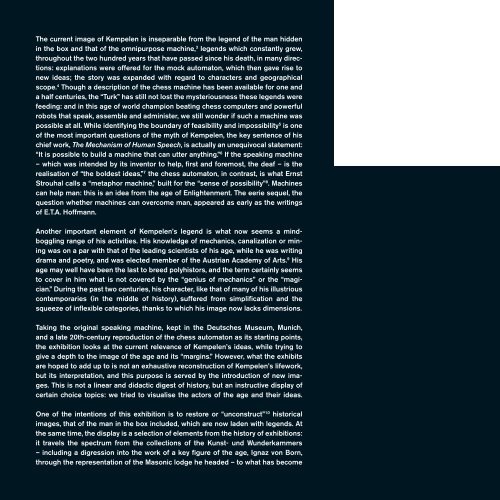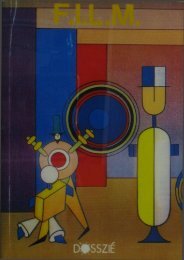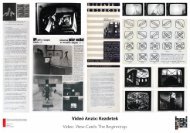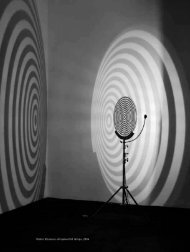You also want an ePaper? Increase the reach of your titles
YUMPU automatically turns print PDFs into web optimized ePapers that Google loves.
The current image of Kempelen is inseparable from the legend of the man hidden<br />
in the box and that of the omnipurpose machine, 3 legends which constantly grew,<br />
throughout the two hundred years that have passed since his death, in many directions:<br />
explanations were offered for the mock automaton, which then gave rise to<br />
new ideas; the story was expanded with regard to characters and geographical<br />
scope. 4 Though a description of the chess machine has been available for one and<br />
a half centuries, the “Turk” has still not lost the mysteriousness these legends were<br />
feeding: and in this age of world champion beating chess computers and powerful<br />
robots that speak, assemble and administer, we still wonder if such a machine was<br />
possible at all. While identifying the boundary of feasibility and impossibility 5 is one<br />
of the most important questions of the myth of Kempelen, the key sentence of his<br />
chief work, The Mechanism of Human Speech, is actually an unequivocal statement:<br />
“It is possible to build a machine that can utter anything.” 6 If the speaking machine<br />
– which was intended by its inventor to help, first and foremost, the deaf – is the<br />
realisation of “the boldest ideas,” 7 the chess automaton, in contrast, is what Ernst<br />
Strouhal calls a “metaphor machine,” built for the “sense of possibility” 8 . Machines<br />
can help man: this is an idea from the age of Enlightenment. The eerie sequel, the<br />
question whether machines can overcome man, appeared as early as the writings<br />
of E.T.A. Hoffmann.<br />
Another important element of Kempelen’s legend is what now seems a mindboggling<br />
range of his activities. His knowledge of mechanics, canalization or mining<br />
was on a par with that of the leading scientists of his age, while he was writing<br />
drama and poetry, and was elected member of the Austrian Academy of Arts. 9 His<br />
age may well have been the last to breed polyhistors, and the term certainly seems<br />
to cover in him what is not covered by the “genius of mechanics” or the “magician.”<br />
During the past two centuries, his character, like that of many of his illustrious<br />
contemporaries (in the middle of history), suffered from simplification and the<br />
squeeze of inflexible categories, thanks to which his image now lacks dimensions.<br />
Taking the original speaking machine, kept in the Deutsches Museum, Munich,<br />
and a late 20th-century reproduction of the chess automaton as its starting points,<br />
the exhibition looks at the current relevance of Kempelen’s ideas, while trying to<br />
give a depth to the image of the age and its “margins.” However, what the exhibits<br />
are hoped to add up to is not an exhaustive reconstruction of Kempelen’s lifework,<br />
but its interpretation, and this purpose is served by the introduction of new images.<br />
This is not a linear and didactic digest of history, but an instructive display of<br />
certain choice topics: we tried to visualise the actors of the age and their ideas.<br />
One of the intentions of this exhibition is to restore or “unconstruct” 10 historical<br />
images, that of the man in the box included, which are now laden with legends. At<br />
the same time, the display is a selection of elements from the history of exhibitions:<br />
it travels the spectrum from the collections of the Kunst- und Wunderkammers<br />
– including a digression into the work of a key figure of the age, Ignaz von Born,<br />
through the representation of the Masonic lodge he headed – to what has become





